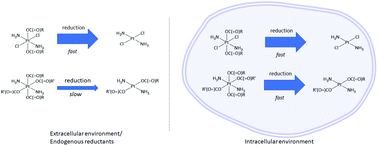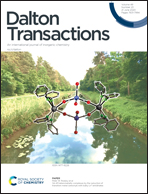trans-Platinum(iv) pro-drugs that exhibit unusual resistance to reduction by endogenous reductants and blood serum but are rapidly activated inside cells: 1H NMR and XANES spectroscopy study†
Abstract
Recent results have confirmed that protection of transplatin from reactions on the path to cancer cells substantially increases their activity, suggesting that such complexes have greater potential than previously thought. In this study we have investigated the use of the platinum(IV) oxidation state and the tetracarboxylate coordination sphere to determine whether these features could impart the same stability to trans-diammineplatinum complexes that they do to cis-diam(m)ineplatinum complexes. The cis complexes exhibit resistance to reduction by L-ascorbate and human blood serum, but are readily reduced inside cancer cells. Studies of reduction monitored by 1H NMR revealed that oxidation of trans-diammineplatinum(II) complexes does not always result in significant stabilisation, but the complexes trans, trans, trans-[Pt(OAc)4(NH3)2] (OAc = acetate) and trans, trans, trans-[Pt(OPr)2(OAc)2(NH3)2] (OPr = propionate) exhibit second order half-lives of 33 h and 5.9 days respectively in the presence of a ten-fold excess of L-ascorbate. XANES spectroscopy studies of reduction in blood models showed that trans, trans, trans-[Pt(OAc)4(NH3)2] is stable in blood serum for at least 24 hours, but is reduced rapidly in whole blood and was observed to have a half-life of approximately 4 hours in DLD-1 colon cancer cells. Consequently, the tetracarboxylatoplatinum(IV) moiety has the properties required to enable the delivery of trans-diammine platinum complexes to cancer cells.



 Please wait while we load your content...
Please wait while we load your content...